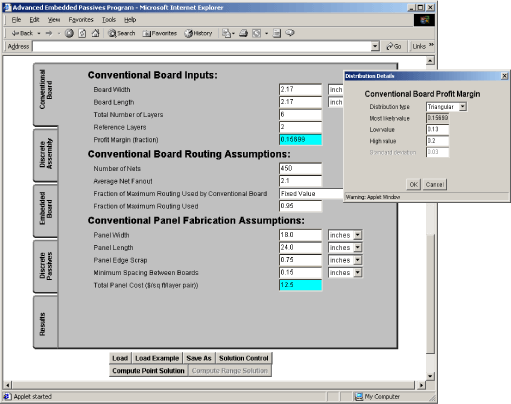
The embedded passives cost analysis software was developed jointly by the NIST Advanced Embedded Passives Consortium and the CALCE Electronic Products and Systems Consortium at the University of Maryland and is supported by the Electronic Systems Cost Modeling Laboratory (ESCML). Access to the software is limited to members of these two consortia. The tool can be reached through the following link: Embedded Passives Cost Analysis Tool (password protected).
Model Description
This model delivers an application-specific economic analysis of the conversion of discrete passive components (resistors and capacitors) to integral passives that are embedded within a printed circuit board. The model performs three basic analyses: 1) Board size analysis is used to determine board sizes, layer counts, and the number of boards that can be fabricated on a panel; 2) Panel fabrication cost modeling including a cost of ownership model is used to determine the impact of throughput changes associated with fabricating integral passive panels; and 3) Assembly modeling is used to determine the cost of assembling all discrete components, and their associated inspection and rework.

Details of the model formulations and examples produced using the model can be found in the following
report:
P. A. Sandborn, B. Etienne, and G. Subramanian, “Application-Specific Economic
Analysis of Integral Passives in Printed Circuit Boards." IEEE
Trans. on Electronics Packaging Manufacturing, Vol. 24, No. 3, pp.
203-213, July 2001.
Software Walkthrough
The software tool is written in Java and is fully functional (including local file system save and load) over the web. The interface consists of four input forms corresponding to the conventional board characteristics, the discrete passive assembly characteristics, the discrete passive component characteristics, and the embedded board characteristics. The four forms are shown below.
|
|
|
|
|
Conventional board input characteristics.
|
Discrete passive assembly input characteristics.
|
|
|
|
|
|
|
Embedded passive board input characteristics.
|
Discrete passive input characteristics.
|
The tool supports full Monte Carlo analysis, allowing each input to be optionally described as a probability distribution (results will be in the form of a probability distribution in this case).
 |
Blue input fields indicate that the variable is described by a probability distribution. Distribution shapes include: Uniform, Triangular, Normal, and Lognormal. |
Several different sets of results can be generated using the tool. Point solutions can be computed for specific combinations of discrete and embedded components. In the case of a point solution, the board size, board price, and relative system costs are computed for conventional and embedded implementations. Range solutions can also be generated where the percentage of embeddable resistors or capacitors are varied and the relative system costs generated.
For more information contact:
sandborn@calce.umd.edu

CALCE Electronic Systems Cost Modeling Laboratory
University of Maryland
Home Page:
http://www.enme.umd.edu/ESCML
Last Updated: October 17, 2001